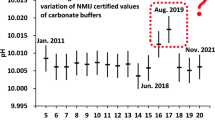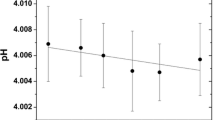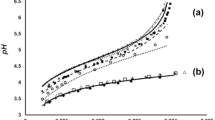Abstract
This paper discusses the basis and historical development of the traceability chain for pH. The quantity pH, first introduced in 1909, is among the most frequently measured analytical quantities. The practical measurement of the pH value of a sample is inexpensive, easy to perform, and yields a rapid result. However, the problems posed by the traceability of pH are not easy to solve. Most pH measurements are performed by potentiometry, using a glass electrode as the pH sensor. Such pH electrodes must be calibrated at regular intervals. Confidence in the reliability of pH measurements requires establishment of a metrological hierarchy including an uncertainty budget for calibration that links the pH measured in the sample to an internationally agreed and stated reference. For pH, this reference is the primary measurement of pH. A traceability chain can be established that links field measurements of pH to primary buffer solutions that are certified using this primary method. This allows the user in the field to estimate the measurement uncertainty of the measured pH data. As the realization of the primary measurement is sophisticated and time-consuming, primary standards are generally realized at national metrology institutes. A number of potentiometric methods are suitable for the determination of the pH of reference buffer solutions by comparison with the primary standard buffers. The choice between the methods should be made according to the uncertainty required for the application. For reference buffer solutions that have the same nominal composition as the primary standard, the differential potentiometric cell, often called the Baucke cell, is recommended.



Similar content being viewed by others
References
Meinrath G, Spitzer P (2000) Microchimica acta 135:155–168
Michaelis L (1914) Die Wasserstoffionenkonzentration. Ihre Bedeutung in der Biologie und die Methoden ihrer Messung. Springer, Berlin
Sørensen SPL (1909) Biochemische Zeitschrift 21:131–200;201–304; continuation (1909) Compt. Rend. Trav. Lab. Carlsberg 8:1–153
Brown RJC, Milton MJT (2007) Chem Soc Rev 36:904–913. doi:10.1039/b507452p
ISO/IEC 17025:2005 (2005) General requirements for the competence of testing and calibration laboratories. ISO, Geneva, Switzerland
Arrhenius S (1887) Z Phys Chem 1:631–648
Friedenthal H (1904) Z Elektrochemie 10:113–119
Haber F, Klemensiewicz Z (1909) Z Phys Chem 67:385–431
Lewis GN, Randall M (1923) Thermodynamics and the free energy of chemical substances. McGraw-Hill, New York
Debye P, Hückel E (1923) Phys Z 24:185–206
Sørensen SPL, Linderstrøm-Lang K (1924) Compt Rend Trav Lab Carlsberg 15:1–40
Bates RG (1948) Chem Rev 42:1–60, cited in Bates RG (1981) CRC Crit Rev Anal Chem 10:247–278
Galster H (1991) pH measurement. VCH, Weinheim, pp 47–52
Bates RG (1973) Determination of pH. Theory and practice, 2nd edn. Wiley, New York
Harned HS, Robinson RA (1928) J Am Chem Soc 50:3157–3178
Harned HS, Ehlers RW (1932) J Am Chem Soc 54:1350–1357
Manual of symbols and terminology for physicochemical quantities and units, 2nd ed., prepared for publication by Whiffen D H (1979). Pure Appl Chem 51:30–31
Covington AK (1981) Anal Chim Acta 127:1–21
Bates RG (1981) The modern meaning of pH. CRC Crit Rev Anal Chem 10:247–278
Covington AK, Bates RG, Durst RA (1985) Pure Appl Chem 57:531–542
Baucke FGK (2002) Anal Bioanal Chem 374:772–777
Spitzer P, Eberhardt R, Schmidt I, Sudmeier U (1996) Fresenius J Anal Chem 356:178–181
Baucke FGK (1997) In: Spitzer P (ed) PTB-report W-68. Physikalisch-Technische Bundesanstalt, Braunschweig, pp 10–20
Baucke FGK, Spitzer P, Naumann R (1998) Anal Chem 70(7):227A
Buck RP, Rondinini S, Baucke FGK, Brett CMA, Camões MF, Covington AK, Milton MJT, Mussini T, Naumann R, Pratt KW, Spitzer P, Wilson GS (2002) Pure Appl Chem 74:2169–2200
Máriássy M, Pratt KW, Spitzer P (2009) Metrologia 46:199–213
Hamer WJ, Acree SF (1939) J Res Nat Bur Stand (US) 23:647–662
Bates RG, Acree SF (1943) J Res Nat Bur Stand (US) 30:129–155
Hamer WJ, Acree SF (1944) J Res Nat Bur Stand (US) 32:215–221
Bates RG, Guggenheim EA (1960) Pure Appl Chem 1:163–168
Spitzer P (2001) Accred Qual Assur 6:55–60
Bates RG, Robinson RA (1980) Solution Chemistry 9:455–456
OIML (1980) pH Scale for Aqueous Solutions, International Recommendation No. 54
Draft International Standard ISO/DIS 26149 Water quality (2000) Determination of pH, ISO, Geneva
DIN 19266 (2000) pH-measurement - Reference buffer solutions for the calibration of pH measuring equipment. Beuth Verlag, Berlin
Spitzer P, Werner B (2002) Anal Bioanal Chem 374:787–795
Baucke FGK (1977) Chem-Ing-Tech 49:739–740
Baucke FGK (1979) Electrochim Acta 24:95–97
Baucke FGK (1994) J Electroanal Chem 68:67–75
Breitenbach M, Echkardt E, Einert P, Moritz M (1980) Mitteilungsblatt der Chemischen Gesellschaft der DDR 27(10):209–214
CMCs in pH, BIPM Data base, Available at http://kcdb.bipm.org/AppendixD/default.asp (date of access : 30 May 2010)
Baucke FGK (1993) Anal Chem 65:3244–3251
Baucke FGK (1994) Anal Chem 66:4519–4524
DIN 19268:2007-05 (2007) pH-measurement of aqueous solutions with pH measuring chains with pH glass electrodes and evaluation of measurement uncertainty
ISO 10523:2008 (2008) Water quality—determination of pH, ISO, Geneva (date of access: 20 April 2010)
De Bievre P, Dybkaer R, Fajgelj A, Hibbert DB (2008) Draft IUPAC recommendation, Available at http://old.iupac.org/projects/2001/2001-010-3-500.html (date of access: 30 May 2010)
IUPAC Project: comparable pH measurements by metrological traceability, 2005, Available at http://www.iupac.org/web/ins/2004-005-2-500 (date of access: 20 April 2010)
Project 843 of EURAMET (European Association of National Metrology Institutes), Available at: http://www.euramet.org/index.php?id=tc-projects (date of access: 20 April 2010)
Guide to the expression of uncertainty in measurement (2008) ISO/IEC Guide 98-3:2008 [JCGM 100:2008] Available at: http://www.bipm.org/en/publications/guides/gum.html
Author information
Authors and Affiliations
Corresponding author
Rights and permissions
About this article
Cite this article
Spitzer, P., Pratt, K.W. The history and development of a rigorous metrological basis for pH measurements. J Solid State Electrochem 15, 69–76 (2011). https://doi.org/10.1007/s10008-010-1106-9
Received:
Revised:
Accepted:
Published:
Issue Date:
DOI: https://doi.org/10.1007/s10008-010-1106-9




